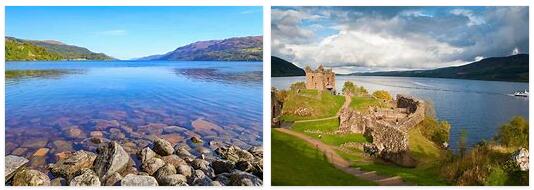Castle Trail
In addition to its breathtaking landscapes, Scotland is especially famous for its numerous small and large castles. A real highlight is the Castle Trail in the Aberdeenshire region in north-east Scotland. Along the only castle route in the entire country, which annually attracts thousands of locals and tourists from all over the world, there are a total of 17 fairy-tale castles, fortresses and fortresses in the middle of the beautiful and natural landscapes. Many tour operators offer the “Castle Trail” as a guided bus tour lasting several days. All castles are easily accessible from Aberdeen, one of the largest cities in the country. Tourists and locals can also explore the castles on their own.
Balmoral Castle: Queen Elizabeth II’s summer residence.
One of the most famous castles along the “Castle Trail” is Balmoral Castle on the River Dee. The castle, built in the 14th century, is the summer residence of the British Queen Elizabeth II. The well-preserved Fyvie Castle from the 12th century can also be visited all year round, as can Crathes Castle and Drum Castle. In addition to the well-preserved palaces and castles, there are also some castle ruins that are well worth seeing on the “Castle Trail”. On one of the popular castle tours, visitors also learn a lot about the exciting and eventful history of the entire region.
Mackintosh Route
Glasgow on foot
The largest city in Scotland with 600,000 inhabitants has long had the image of a gray working-class town. Fortunately, that has changed significantly since the 1990s, when Glasgow became the European Capital of Culture. In 1999 the metropolis received the architecture and design award. There is a lot to be admired in Glasgow in terms of architecture. Many important buildings in the city – such as the Kelvingrove Museum and the Glasgow School of Art – are the work of the architect Charles Rennie Mackintosh. The most important houses of his work can be admired on a fascinating tour through Glasgow, the so-called “Mackintosh Route” – a must for study trips. It takes about four hours and is 13 kilometers.
Charles Rennie Mackintosh
The Scottish designer, architect, graphic artist and painter Charles Rennie Mackintosh was born in Glasgow in 1868 and died impoverished in London in 1928. He was part of the artist group “The Four”, which influenced both the Glasgow School and the Art Nouveau movement. Modern Art would be inconceivable without him.
The individual sections of the Mackintosh Route
The Mackintosh Trail consists of nine individual sections. The tour begins at Central Station in the heart of downtown Glasgow and first takes you to Reinfield Lane, where the Daily Record Building is located. The second section leads to the pedestrian zone of Sauchiehall Street, where the Willow Tea Rooms are located. The rooms there have been accessible again since 1983. From there it goes to Mackintosh’s masterpiece – the Glasgow School of Art. Then the route leads to the Kelvingrove Art Gallery and the attached museum. The 1906 to 1914 residence of Mackintosh and his wife was reconstructed on Florentine Terrace. From the Riverside Museum you walk over the Clyde Arc Road Bridge to Scotland Street School, Mackintosh’s last work for the City of Glasgow.
Loch Ness
Loch Ness is one of the beautiful and well-known travel destinations in Scotland. Some remember the legend surrounding the ‘Loch Ness Monster’, while others take a study trip to the 56 square kilometer freshwater lake in the Scottish highlands. Loch Ness is 37 kilometers long, one and a half kilometers wide and up to 230 meters deep in places. The lake was created in the Ice Age by a large number of glaciers. The Highland Council Area is one of two and a half dozen administrative districts that make up Scotland.
Drumnadrochit – destination for tourists en route to Loch Ness
On the west bank of Loch Ness lies the small but well-known community of Drumnadrochit. The place itself has a good thousand inhabitants. In addition, there are numerous tourists and study travelers throughout the year. Your holiday in the Scottish Highlands naturally includes a boat trip on Loch Ness to catch a glimpse of Nessie, the legendary monster. Hikes and excursions through the highlands around the lake are much more realistic. In the village itself, tourists can find out more about the Loch Ness monster and the cryptozoology associated with it in two visitor centers. The guest can choose between hotel, farmhouse and guest house for his accommodation. Via the A82, which runs through the Western Highlands,
Loch Ness is considered to be one of the most fish-rich lakes in Great Britain. Anglers have the best chance of a good catch all year round, whatever the weather. The area around Loch Ness is generally quite wooded with deciduous and coniferous trees. The Loch Ness Marathon in autumn is an annual highlight in this region. The route runs along the lakeshore from Whitebridge. It is both challenging and delightful with its panoramic view of the lake.
Loch Ness offers a lot more to every visitor than the mostly unsuccessful search for Nessie.
